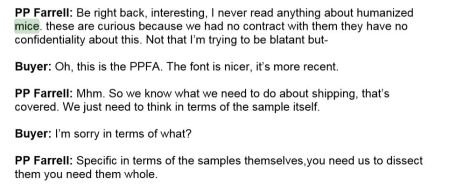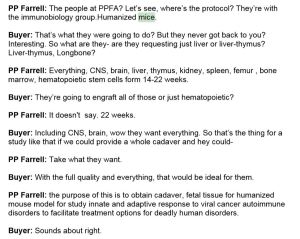Planned Parenthood uses aborted baby parts for humanized mice research
H/T to blogger Jill Stanek who points out that some of the requested “fetal cadavers” from Planned Parenthood in Houston are for experimentation with humanized mice. #humanizedmice .
The Center for Medical Progress released a 5th video showing the nation’s largest Planned Parenthood abortion facility offering intact fetal cadavers which they refer to as “specimens.”
Center for Medical Progress, posing as buyers for a Biotech company sat with the Director of Research for Planned Parenthood Gulf Coast, Melissa Farrell, at the abortion-clinic headquarters of Planned Parenthood Gulf Coast in Houston, Texas.
CMP’s 5th video transcript implies Planned Parenthood is using the aborted babies for “mice” studies and “Humanized mice”.
_______________________________________________________________________
An article published in Science in the News a Harvard Graduate Student Group at the Harvard Graduate School of the Arts and Sciences explains humanized mice:
-
Humanized mice are otherwise ordinary breeds of lab mice that have human cells, tissues, or organs. These types of mice are frequently used by immunologists, who give the mice a mostly-human immune system, but they can also be used to study other body systems. This permits researchers to study different aspects of human biology and the effects of certain drugs or disease treatments using experiments that would otherwise be unethical to conduct on a human being and don’t have safer substitutes.
How are mice humanized?
Fetal liver and thymus tissue used as well something Stem Express gets big bucks for
-
The process of humanizing mice requires the transfer of 17-19 week old human fetal tissue into young mice, 6-8 weeks of age, with weakened immune systems. If a mouse with a normal immune system received human tissue, it would start to reject the tissue immediately after the transfer because its immune system would recognize the added tissue as foreign. This process, graft rejection, also happens in humans who receive incompatible organ transplants. Therefore, researchers use mice with a genetically weakened immune system for the humanization procedure. These genetically immunosuppressed mice tolerate the presence of foreign human tissue for long enough to conduct experiments [].
Because a mouse’s body is full of its own immune cells, it is essential to remove these cells to create “space” for the human immune cells to populate. To do this, the mice are subjected to a sub-lethal dose of irradiation. Next, to create a niche where the cells can be constantly replenished, the scientists make a small surgical incision to implant human fetal liver and thymus tissue underneath the mouse’s kidney. Finally, human stem cells are injected directly into the mouse’s blood. 17-20 weeks after this procedure, the reconstitution is considered complete when the cells have divided sufficiently to populate their “home” in the mouse’s body. A number of variations to the technique can be introduced depending on the experimental question that needs to be addressed, but most labs follow this general procedure.
These details from the Jackson Laboratory talk about, “engrafting human CD34+ hematopoietic stem cells (hHSCs) alone (hu-CD34 NSG™) or in combination with human fetal thymus and liver tissue transplanted under the kidney capsule.”
Read more details here .
They offer Humanized Mice “shipped to you” using fetal livers and thymus:
NOTE: there is no indication that the fetal organs used by the Jackson Lab were from aborted babies though.
But, according to their website, the Jackson Laboratory was founded in 1929 as The Roscoe B. Jackson Memorial Laboratory by Clarence Cook Little an advocate of eugenics.
-
Little created the first inbred (genetically uniform) mouse strains and wanted to use them experimentally to establish that cancer was a genetic disease, not an infectious disorder, as was widely thought at the time. He gained initial financial support for the Laboratory from Detroit industrialists Edsel Ford, president of the Ford Motor Company, and Roscoe B. Jackson (for whom the Laboratory is named), president of the Hudson Motorcar Company.
Clarence Cook Little was the President of Margaret Sanger’s American Birth Control League (ABCL), at the same time he also sat on a pro-euthanasia panel.
Sanger is the founder of Planned Parenthood.
Clarence Cook Little was also member of the Committee on Planned Parenthood:
Read more on Little here.
In a previous post, I explain how aborted baby parts are being implanted into animals and how some of those parts are coming from Stem Express, a fetal tissue procurement company used by Planned Parenthood.
The research, co-authored by Eugene Guhe founder and CEO of Ganogen, Inc., a biotech company in Redwood City, California, raises a number of ethical questions, including whether it is acceptable to use human fetal organs in research, or to transplant human organs into animals. If the research moves forward, it must be determined that the organs were obtained with proper consent, and that the research was conducted with adequate oversight, experts told CBS News.
On their website, Ganogen, Inc., says that they have found a way to successfully transplant human fetal kidneys, livers, hearts, lungs, and other organs into animal hosts using advanced microsurgery.
“After transplantation, the fetal organ continues to grow and mature. It even demonstrates function, and in the case of the kidney, can keep the host animal alive all on its own,” they explain.
According to CBS, Gu and his colleagues obtained human fetal kidneys from Stem Express, a Placerville, California-based company that supplies researchers with tissue from deceased adults and fetuses.
On their website, Stem Express writes that their “human tissue products range from fetal to adult and healthy to diseased, and we also collect bone marrow and leukapheresis for isolation.”
They go on to say that, “Working with hospitals and clinics across the United States, all human tissue and blood procurement is performed in accordance with IRB-approved protocols and consents. Protecting the privacy of our researchers and donors is always the highest priority at StemExpress.”
Read here.














August 4, 2015 at 6:36 pm
[…] Just another WordPress.com weblog « Planned Parenthood uses aborted baby parts for humanized mice research […]
August 4, 2015 at 7:36 pm
[…] Planned Parenthood uses aborted baby parts for humanized mice research […]
August 4, 2015 at 9:36 pm
[…] addition, CMP’s 5th video transcript implies Planned Parenthood is using the aborted babies for “mice” studies and “Humanized […]
August 5, 2015 at 2:16 pm
Reblogged this on Expose Sex Ed Now!.
August 6, 2015 at 3:07 pm
[…] Read more here: Planned Parenthood uses aborted baby parts for humanized mice research […]
August 6, 2015 at 7:25 pm
[…] The latest transcripts released by the Center for Medical Progress revealed that Planned Parenthood was using aborted baby parts for humanized mice research. […]
February 2, 2016 at 5:28 am
[…] research being done is humanized mice. Scientists inject the mouse with fetal tissue so the mouse is genetically altered to accept the […]
August 22, 2017 at 8:08 am
[…] was named the director of The Jackson Laboratory and later accepted a position as scientific director of the Tobacco […]
September 6, 2018 at 2:29 am
[…] research being done is humanized mice. Scientists inject the mouse with fetal tissue so the mouse is genetically altered to accept the […]